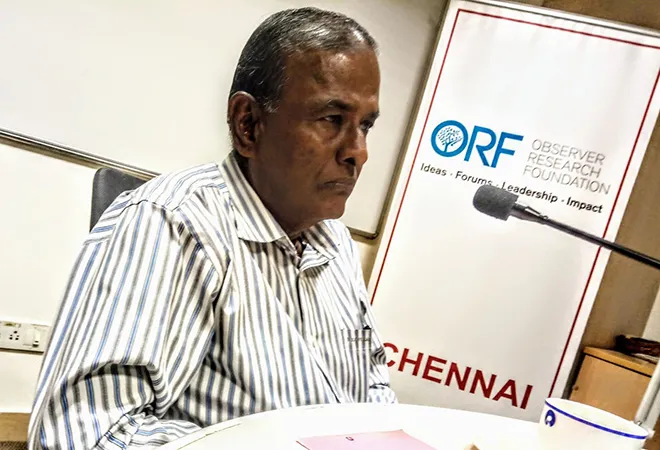“Peace in Kashmir will come only through statesmanship and high-level action, not through security forces,” said Col Francis (retd), while initiating a discussion on “J&K: A military perspective” at Observer Research Foundation, Chennai, on 12 May 2018. Using the 1965 India-Pakistan War as the peg, Col. Francis assessed several changes that had taken place both in world politics and in the sub-continent, especially since 1989, which have had repercussions for the future of Kashmir Valley.
Since the fall of communism in Eastern Europe and the liberalisation of the Indian economy post-1991, India is being seen by the larger international community as an emerging power. Along with these changes and the penetrating instability in neighbouring Afghanistan, there has also been a growing realisation that the ‘Kashmir problem’ needs a political solution, not a military one, Col. Francis said.
Going over in detail the many stages of the 1965 war, beginning with ‘Operation Desert Hawk’ in the Rann of Kutch region, followed by ‘Operation Gibraltar’ and its sequel ‘Operation Grand Slam’, Col Francis highlighted that a knowledge of geography was crucial in understanding the nature of these battles. The crucial importance of the Karakoram and Himalayan mountain ranges in protecting Ladakh also further highlight the importance of geography and landscape in determining outcomes in conflict.
Great strategic value
Col. Francis illustrated in great depth the importance of Haji Pir Pass, Pakistan’s main logistic base for ‘Operation Gibraltar’. Haji Pir Pass, Pt- 13620 looked over Kargil town and many other tactically-important areas. This led the speaker to address the still looming question, ‘Why did India agree to return Haji Pir Pass during the talks at Tashkent?’ When the discussion began in January 1966 at Tashkent, between India and Pakistan, with host Soviet Union playing facilitator, India had to take into account the threat posed by Pakistan in Chhamb. “It was important to remember Chhamb was a weak-spot for us,” he said.
At this time, Pakistani forces had already reached Fatwal Ridge, which was perilously close to Akhnoor. While control over Haji Pir would have reduced the distance from Jammu to Srinagar through Poonch and Uri by 200 km, Col. Francis pointed out that Akhnoor was of great strategic value for India.
When Pakistan attacked Chhamb, their aim was to capture Akhnoor and cut off areas west of the Chenab River, and effectively Jammu from the rest of India. Had the attack succeeded, this would have been a serious setback for India. The crucial question, asked Col. Francis, was this –‘Do we want access to Poonch or do we want Haji Pir Pass?’ He believed that returning Haji Pir Pass while asking Pakistan to withdraw from Chhambh was a wise decision. He further added that India would have inherited a lot of insurgencies from the surrounding areas had it retained Haji Pir even as early as that period.
Each and every battle of the 1965 War was worth studying as a separate case study, observed Col. Francis. There were important lessons to be learnt from them. The importance of ‘Operation Bakshi’ for instance lay in its significance as a holding attack. Only close analyses of these battles bring out the importance of the Bulges such as Haji Pir Pass and Shakahar Garth Bulge.
Several challenges
Col. Francis insisted that in order to understand the situation in Jammu & Kashmir, it was important to not equate anti-India protests as being pro-Pakistan, as well as to remember that ‘azadi’ did not mean freedom from India but freedom from (alleged excesses by) security forces. It was true that the presence of large numbers of security and military forces in the Kashmir Valley today had curbed the freedom of the people in the region, he said, adding that this was also a case of action and reaction.
There remained several challenges in Kashmir Valley that the growing instability highlighted, and these needed to be addressed urgently, he said. He also noted that more and more educated men with good family background were seen as joining anti-government militia groups. China’s role in pushing for CPEC with Pakistan was also something of a challenge to India.
Whom to talk to?
Contrarian views emerged during the Q&A and discussion rounds, where it was also argued by others that China may well have a positive role to play in the region despite India’s current reservations. Bringing infrastructure to this region may tone down the instability and radicalisation of youth.
“What are the changing views of the people of Kashmir?” Has this stopped being a religious war and simply a war motivated by power grabbing? What are the options available to normalise India Pak relations?” These questions needed to be discussed and debated urgently. The other key question vis-à-vis Pakistan, which it appeared India hadn’t resolved adequately, was: “To whom do we talk to in Pakistan, the civilian government, Pakistan army or the ISI?”
Col. Francis concluded by saying that engagement was the key to a peaceful resolution of the crisis. While India’s strategic community and its foreign policy analysts were debating several alternatives for addressing the deadlock in relations between India and Pakistan, such as cricket diplomacy, revoking MFN status and cutting off trade ties, Col. Francis felt there was no better alternative to diplomacy. These two countries urgently needed to use the tools of diplomacy, not confrontation, to move along relations.
The final remaining question was this: “Can India agree to the conversion of the Line of Control (LoC) into de facto boundary?” Col. Francis believed this could be an option. Looking to the future, he said two important tasks faced India – working towards an incident-free LOC through Track-2 and Track-1.5, and de-radicalisation of the youth in the Kashmir Valley.
This report was prepared by Dr. Vinitha Revi, Research Associate, Observer Research Foundation, Chennai
The views expressed above belong to the author(s). ORF research and analyses now available on Telegram! Click here to access our curated content — blogs, longforms and interviews.




 PREV
PREV

